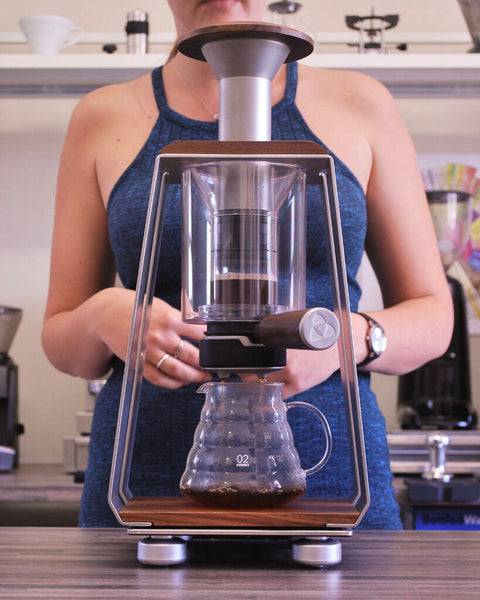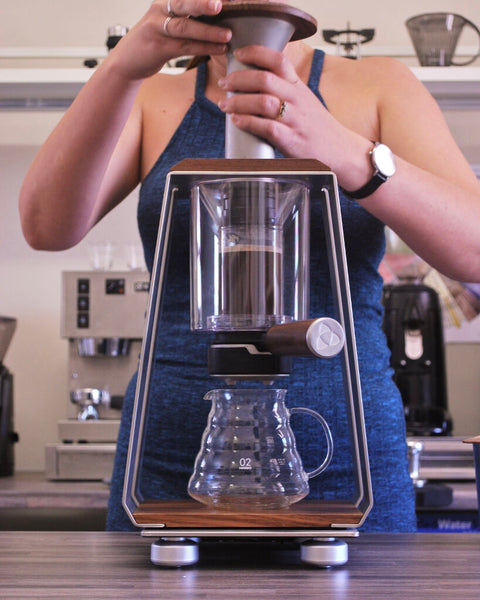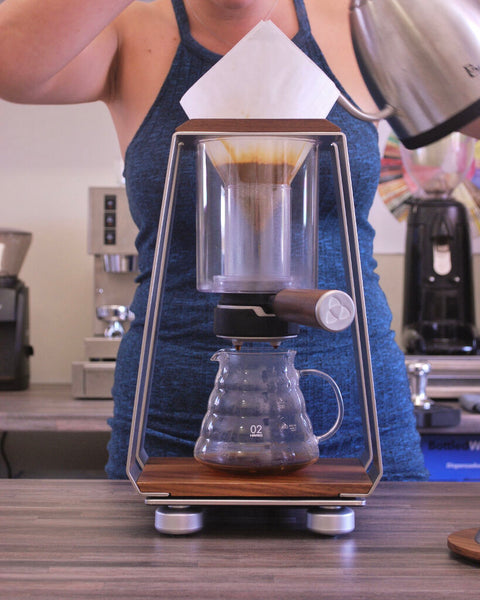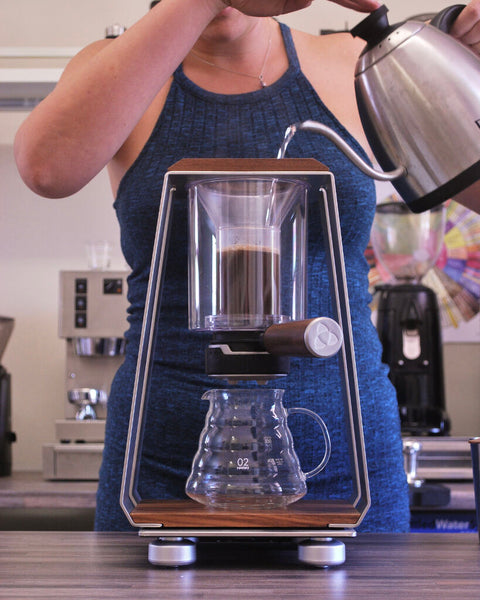The Trinity ONE Brewer - A Closer Look
If you have a Trinity ONE Brewer or even if you’re just considering buying one, this blog post includes some information to help you along the way. Here at CCBHQ we’ve spent a few months testing out the Trinity and identifying our preferred brewing variables. I’ve personally, come to love the press method because of the consistency that the weight provides to the action of pressing, but it has also been fun to experiment with the other methods the brewer offers. Below you’ll find our recommendations on how to get the best out of your Trinity brewer, in each of those methods.

Of course everything in this blog post is open to discussion and I’d encourage you to join the conversation with your findings, questions or feedback in the comments section below. We’d love to hear what works best for you and to test out new ideas!
About the Trinity ONE Brewer
The Trinity ONE Brewer was created by Australian inventor Mark Folker, who wanted to combine his love of coffee and his engineering background to produce the world's first multi-purpose, manual brewing appliance.
The Trinity ONE might be best known for the clever way it makes Aeropress-style brews with its own built in weight (no pressing required), but it’s also designed to brew pour-overs, and immersion-style brews, making it a very cool 3-in-1 coffee maker.
Why I personally love the Trinity ONE
I love the convenience of having three brew methods in one coffee maker. You might say it’s actually four brew methods because you can also make cold brew. The makers of the Trinity themselves market it as three brew methods in one brewer: press, immersion and drip. In my mind I think of it as Aeropress, French press and pour-over.
I also love how consistent it is. If I use consistent brewing parameters, I get quite consistent results, and as you probably know, consistency is very important in coffee brewing!
Lastly, I love the Trinity’s looks. It is a beautiful piece of equipment to have in your kitchen at home or even on the counter in your café.
Challenges you might face in using the Trinity ONE Brewer
The Trinity Brewer definitely excels when you are very precise with your parameters, but on the other hand if you’re not precise with your parameters you may find it less forgiving than other manual coffee brewers. For example, I found that if I didn’t start the press at exactly 45s and was a little late, then the brew would run much longer than I intended, making a big difference to the extraction and flavour.
I also found that the grind size needed to be perfectly ‘dialled in’. If the grind size was too fine then the extraction would be completely off. This was particularly true with the press method, where too fine of a grind would slow down the press cylinder significantly.
Having said all that, with the correct variables, the results from the Trinity ONE Brewer are truly delicious. Below you’ll find the recipes I used to get the tastiest results.
Trinity ONE Press Method

You will need:
- Your Trinity ONE Brewer
- A kettle (ideally with temperature control or a thermometer)
- A scale (one that can hold a lot of weight, remember the trinity is ~3.5kgs on its own)
- A coffee grinder
- An Aeropress paper/stainless steel filter
- Something to stir your coffee (ideally something with a flat surface)
- A decanter to brew into
- Some delicious fresh coffee beans (obviously)
Brewing Guide:
Step 1: Heat your water
You would ideally like your water to be at 93ºC when you start brewing. You are going to need 250ml of water so you should heat about 500ml of water for brewing and rinsing purposes.
Step 2: Weigh out 17.5g of coffee beans
You will need 17.5g of coffee for the 250ml of water. On the Severin we have in the shop I used a grind size of 5. On a Baratza Encore grinder, I’d recommend a grind setting of 12. Basically you will need to grind on the same setting that you would for an Aeropress which is medium fine coarseness.
Don’t grind your coffee just yet, as you want it to be as fresh as possible so wait for your kettle to finish boiling first.
Step 3: Prepare the Trinity
Add an Aeropress paper or stainless steel filter into the portafilter on the Trinity. Insert your portafilter into your Trinity ONE brewing chamber, lock it into place and open the valve. Once your kettle has come to temperature, preheat your Trinity and wet your filter by pouring some water over the top. When all the water has poured through you can now close the valve on the portafilter.
Step 4: Grind your coffee and tare the scale
Now you can grind your beans and check that your water is at 93ºC. Add your 17.5g of coffee into the brewing chamber. Put your Trinity on the scale, put your decanter in place and 0 your scale and timer. Have your cap, stirrer and Trinity press cylinder ready to go.
Step 5: Add 250ml of water in two stages and stir
Add 100ml of water and start your timer. Start by pouring the water into the middle first and then go out in circles. Do not just pour the water down the sides of the brew chamber as then you’ll find you get inconsistent extraction as the coffee grounds on the side will be in contact with more water than the grinds in the middle.
Once you reach 100ml stop pouring and gently stir the coffee into the water so everything is evenly wet. At 20 seconds pour the rest of your water, up to 250ml and then gently stir once more. Be careful not to touch the filter when you are stirring as you might lift the filter up.
Step 6: Press (2m30s)
After your second stir place the filter cap on the Trinity without the weight attached. At 45 seconds open the valve and then put the weighted press cylinder into the cap. The weight should then begin to press the coffee and water down. You want this process to finish within about 2m45s of total brew time.
Step 7: Clean up
Once all your coffee has dripped through you can then close the valve and remove your decanter. Leave the weight in the chamber as it will push the wet grounds down into the portafilter to make it easier to remove them. If the grinds are still stuck to the cap then remove the cap with the portafilter. Knock your old wet grounds and filter out of the portafilter and wipe down the cap.
You can now insert your portafilter back into the Trinity and leave the valve open. Use another decanter and pour hot water through the brew chamber and portafilter to clean out any remaining coffee. You can leave your valve open for the rest of the water to drip through until your Trinity is dry.
Trinity ONE Drip Method

You will need:
- Your Trinity ONE Brewer
- A kettle (ideally with temperature control or a thermometer)
- A scale (one that can hold a lot of weight, remember the trinity is ~3.5kgs on its own)
- A coffee grinder
- A Hario size 03 filter, or a Chemex folded square/circle filter
- Something to stir your coffee (ideally something with a flat surface)
- A decanter to brew into
- Some delicious fresh coffee beans (obviously)
Brewing Guide
Step 1: Heat your water
You would ideally like your water to be at 93ºC when you start brewing. You are going to need 400ml of water so you should heat about 600ml of water for brewing and cleaning purposes.
Step 2: Weigh out 28g of coffee beans
You will need 28g of coffee for the 400ml of water. On the Severin we have at CCBHQ I used a grind size of 10, and on the Baratza Encore, I used a grind size 16. You will need to grind on the same setting that you would for a pour-over which is on the coarser side of filter.
Don’t grind your coffee just yet, as you want it to be as fresh as possible so wait for your kettle to finish boiling first.
Step 3: Prepare the Trinity
Add a Hario size 03 filter, or a Chemex folded square/circle filter to the top of the Trinity brew chamber. Insert your portafilter, lock it into place and make sure that it is turned to open and then place a decanter under the portafilter.
Once your kettle has come to temperature, start your grinder and preheat your Trinity while wetting your filter by pouring some water through.
Step 4: Grind your coffee and tare your scale
When all the water has poured through you can now put your Trinity onto the scale, tare the scale and add your 28g of ground coffee into your paper filter at the top. You can tare your scale one more time to be ready to brew.
Step 5: Add your 400ml of water in five pours of 80ml
Tap the Trinity a bit with the palm of your hand to try get your grounds level. In a spiral motion, starting in the centre, pour your water over your grounds until you get to 80g of water then stop (make sure you get all the way to the outside so all the coffee is in contact with water) and start your timer.
Wait 45 seconds (this is known as your bloom). At 45s start another pour (you’ll pour in exactly the same way every time, starting in the middle, spiraling to the outside and then coming back in) of 80g of water. You will now pour 80g of water every 15 seconds until you get to 400g. Once you’ve poured all your water, wait for all the coffee to drip through and then you can close the valve on your portafilter.
The total brewing time will vary depending on the coffee and the type of filter you use
Step 6: Clean up
Remove and discard the paper filter and spent coffee grounds. Put an empty decanter under the brewer and open the valve on the portafilter. Run some hot water through the brew chamber and portafilter to give it a good rinse.
Trinity ONE Immersion Method

You will need:
- Your Trinity ONE Brewer
- A kettle (ideally with temperature control or a thermometer)
- A scale (one that can hold a lot of weight, remember the trinity is ~3.5kgs on its own)
- A coffee grinder
- An Aeropress paper/stainless steel filter
- Something to stir your coffee (ideally something with a flat surface)
- A decanter to brew into
- Some delicious fresh coffee beans (obviously)
Brewing Guide
Step 1: Heat your water.
You would ideally like your water to be at 93ºC when you start brewing. You are going to need 250ml of water so you should boil about 500ml for brewing and rinsing purposes.
Step 2: Weigh out 17.5g of coffee beans
You will need 17.5g of coffee for the 250ml of water. On a Severin grinder I used a grind size 11 and on the Encore I used a grind size 19/20. Basically you will need to grind on the same setting that you would for French press, so it needs to be quite coarse.
Don’t grind your coffee just yet, as you want it to be as fresh as possible so wait for your kettle to finish boiling first.
Step 3: Prepare your Trinity.
Add an Aeropress paper or stainless steel filter into the portafilter on the Trinity. Insert your portafilter into your Trinity brewing chamber, lock it into place and open the valve. Once your kettle has come to temperature, preheat your Trinity and wet your filter.
When all the water has poured through you can now close the valve on the portafilter.
Step 4: Grind your coffee and tare your scale
Now you can grind your beans and check that your water is at 93ºC. Put your Trinity on the scale, add your ground coffee and tare your scale and timer. Have your cap, stirrer and Trinity weight ready to go.
Step 5: Add your 250ml of water
Add your 17.5g of coffee into the chamber and then add all 250ml of water and start your timer. Gently stir the grinds into the water in a back and forth motion 5 times. At 1 minute gently stir once again in a back and forth motion 3 times. Do be careful to not touch the filter when you are stirring as I did find that sometimes if I stirred too vigorously then it lifted the filter up.
Step 6: Open the portafilter
After your second stir wait until 2 minutes. Now open the valve on your portafilter and stir in a circular motion 5 times to start the process of the coffee dripping through the portafilter.
The total brew time should be around 3:30-4 minutes.
Step 7: Cleaning
Remove the portafilter from the brew chamber and throw the puck and paper filter into the bin. Insert the portafilter back into the chamber and put an empty decanter under the portafilter and open the valve. Run some hot water through the brew chamber and portafilter to give it a good clean.
Once you’ve had a chance to try one or all of these brew method suggestions, we’d love to hear what you think in the comments below!
About the author
 Michaela joined the Cape Coffee Beans team as a Customerista in 2018 and has quickly become a central part of the team. When she's not busy making our customers happy, she's working closely with our suppliers to source equipment, all while making sure everything runs smoothly at CCBHQ.
Michaela joined the Cape Coffee Beans team as a Customerista in 2018 and has quickly become a central part of the team. When she's not busy making our customers happy, she's working closely with our suppliers to source equipment, all while making sure everything runs smoothly at CCBHQ.
She loves her coffee (even if sometimes she puts milk in it) and is a great person to talk to about any brew method, including the Trinity ONE! You can reach her on any one of our support channels if you have any questions.
